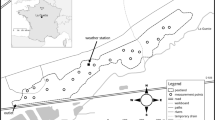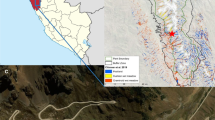Abstract
Abundant production of organic matter that decomposes slowly under anaerobic conditions can result in substantial accumulation of soil organic matter in wetlands. Tedious means for estimating production and decomposition of plant material, especially roots, hampers our understanding of organic matter dynamics in such systems. In this paper, I describe a study that amended typical estimates for both production and decomposition of organic matter by measuring net flux of carbon dioxide (CO2) over the peat surface within a conifer swamp, a sedge-dominated marsh, and a bog in the Appalachian Mountain region of West Virginia and western Maryland, USA. The sites are relatively productive, with net primary production (NPP) of 30 to 82.5 mol C m−2 yr−1, but peat deposits are shallow with an average depth of about 1 m. In summer, all three sites showed net CO2 flux from the atmosphere to the peat during the daytime (−20.0 to −30.5 mmol m−2 d−1), supported by net photosynthesis, which was less than net CO2 flux from the peat into the atmosphere at nighttime (39.2 to 84.5 mmol m−2 d−1), supported by ecosystem respiration. The imbalance between these estimates suggests a net loss of carbon (C) from these ecosystems. The positive net CO2 flux seems to be so high because organic matter decomposition occurs throughout the peat deposit — and as a result concentrations of dissolved inorganic carbon (DIC) in peat pore waters reached 4,000 Μmol L−1 by late November, and concentrations of dissolved organic carbon (DOC) in peat pore waters reached 12,000 Μmol L−1. Comparing different approaches revealed several features of organic matter dynamics: (i) peat accretion in the top 30 cm of the peat deposit results in a C accumulation rate of about 15 mmol m−2 d−1; however, (ii) the entire peat deposit has a negative C balance losing about 20 mmol m−2 d−1.
Similar content being viewed by others
References
Benstead, J., and Lloyd, D.: 1994, Direct mass spectrometric measurement of gases in peat cores. FEMS Microbiol. Ecol. 13, 233–240.
Billings, W.D., Peterson, K.M., Shaver, G.R., and Trent, A.W.: 1977, Root growth, respiration, and carbon dioxide evolution in an arctic tundra soil. Arct. Alp. Res. 9, 129–137.
Brinson, M.M., Lugo, A.E., and Brown, S.: 1981, Primary productivity, decomposition and consumer activity in freshwater wetlands. Ann. Rev. Ecol. Syst. 12, 123–161.
Brock, T.C.M., and Bregman, R.: 1989, Periodicity in growth, productivity, nutrient content and decomposition of Sphagnum recurvum-var-mucronatum in a fen woodland. Oecologia 80, 44–52.
Conlin, T.S.S., and Lieffers, V.J.: 1993, Seasonal growth of black spruce and tamarack roots in an Alberta peatland. Can. J. Bol. 71, 359–360.
Coyne, P.I., and Kelley, J.J.: 1975, CO2 exchange over the Alaskan arctic tundra: meteorological assessment by an aerodynamic method. J. Appl. Ecol. 12, 587–611.
Craft, C.B., and Richardson, C. J.: 1993, Peat accretion and nitrogen, phosphorus and organic carbon accumulation in nutrient-enriched and unenriched Everglades peatlands. Ecol. Appl. 3, 446–458.
Dalva, M., and Moore, T.R.: 1991, Sources and sinks of dissolved organic carbon in a forested swamp catchment. Biogeochemistry 15, 1–19.
Denmead, O.T.: 1991, Sources and sinks of greenhouse gases in the soil-plant environment. Vegetatio 91, 73–86.
Fahey, T.J.: 1992, Mycorrhizae and forest ecosystems. Mycorrhiza 1, 83–89.
Fan, S.M., Wofsy, S.C., Bakwin, P.S., Jacob, D.J., Anderson, S.M., Kebabian, P.L., McManus, J.B., Kolb, C.E., and Fitzjarrald, D.R.: 1992, Micrometeorological measurements of CH4 and CO2 exchange between the atmosphere and subarctic tundra. J. Geophys. Res. 97, 16,627–16,643.
Finer, L: 1989, Fine root length and biomass in a pine mixed birch-pine and spruce stand on a drained peatland. Suo (Helsinki) 40, 155–161.
Giblin, A.E., Nadelhoffer, K.J., Shaver, G.R., Laundre, J.A., and Mckerrow, A.J.: 1991, Biogeochemical diversity along a riverside toposequence in arctic Alaska. Ecol. Monogr. 61, 415–435.
Gorham, E.: 1991, Northern peatlands: role in the carbon cycle and probable responses to climatic warming. Ecol. Appl. 1, 182–195.
Grigal, D.F., Buttleman, C.G., and Kernik, L.K.: 1985, Biomass and productivity of the woody strata of forested bogs in northern Minnesota. Can. J. Bot. 63, 2416–2424.
Grulke, N.B., Riechers, G.H., Oechel, W.C., Hjelm, U., and Jaeger, C.: 1990, Carbon balance in tussock tundra under ambient and elevated atmospheric CO2. Oecologia 83, 485–494.
Hesslein, R.H.: 1976, An in situ sampler for close-interval interstitial water studies. Limnol. Oceanogr. 21, 912–914.
Johnson, L.C., Damman, A.W.H., and Malmer, N.: 1990, Sphagnum macrostructure as an indicator of decay and compaction in peat cores from an ombrotrophic south Swedish peat-bog. J. Ecol. 78, 633–647.
Kirn, J., and Verma, S.B.: 1992, Soil surface CO2 flux in a Minnesota peatland. Biogeochemistry 18, 37–51.
Luken, J.O., and Billings, W.D.: 1985, The influence of microtopographic heterogeneity on carbon dioxide efflux from a subarctic bog. Holarc. Ecol. 8, 306–312.
Malmer, N., and Wallen, B.: 1993, Accumulation and release of organic matter in ombrotrophic bog hummocks processes and regional variation. Ecography 16, 193–211.
Marin, L.E., Kratz, T.K., and Bowser, C.J.: 1990, Spatial and temporal patterns in the hydrogeochemistry of a poor fen in northern Wisconsin. Biogeochemistry 11, 63–76.
Maxwell, J.A., and Davis, M.B.: 1972, Pollen evidence of pleistocene and holocene vegetation on the Allegheny Plateau, Maryland. Quat. Res. 2, 506–530.
McKnight, D.M., Thurman, E.M., Wershaw, R.L., and Hemond, H.F.: 1985, Biogeochemistry of aquatic humic substances in Thoreau's Bog, Concord, Massachusetts. Ecology 66, 1339–1352.
Moore, T.R.: 1986, Carbon dioxide evolution from subarctic peatlands in eastern Canada. Arct. Alp. Res. 18, 189–193.
Moore, T.R.: 1987, Patterns of dissolved organic matter in subarctic peatlands. Earth Surf. Processes Landforms 12, 387–397.
Moore, T.R.: 1989, Plant production, decomposition, and carbon efflux in a subarctic patterned fen. Arct. Alp. Res. 21, 156–162.
National Oceanic and Atmospheric Administration: 1988, Local climatological data, West Virginia report. Natl. Clim. Data Cent., Asheville, N.C.
Neumann, H.H., den Hartog, G., King, K.M., Chipanshi, A.C.: 1994, Carbon dioxide fluxes over a raised bog at the Kinosheo Lake tower site during the northern wetlands study (NOWES). J. Geophys. Res. 99, 1529–1538.
Nilsson, M., and Bohlin, E.: 1993, Methane and carbon dioxide concentrations in bogs and fens — with special reference to the effects of the botanical composition of the peat. J. Ecol. 81, 615–625.
Nobel, P.S.: 1983, Biophysical plant physiology and ecology, W.H. Freeman, San Francisco. 608 pp.
Oechel, W.C., Hastings, S.J., Vourlitis, G., Jenkins, M., Riechers, G., and Grulke, N.: 1993, Recent change of arctic tundra ecosystems from a net carbon dioxide sink to a source. Nature 361, 520–523.
Rochefort, L., Vitt, D.H., and Bayley, S.E.: 1990, Growth, production and decomposition dynamics of Sphagnum under natural and experimentally acidified conditions. Ecology 17, 1986–2000.
Schlentner, R.E., and Van Cleve, K.: 1985, Relationships between CO2 evolution from soil, substrate temperature, and substrate moisture in four mature forest types in interior Alaska. Can. J. For. Res. 15, 97–106.
Silvola, J., and Heikkinen, S.: 1979, CO2 exchange in the Empetrum nigrum-Sphagnum fuscum community. Oecologia 37, 273–283.
Sjors, H.: 1950, On the relation between vegetation and electrolytes in north Swedish mire waters. Oikos 2, 241–258.
Sternberg, L.D.S.L.O.: 1989, A model to estimate carbon dioxide recycling in forests using carbon-13 carbon-12 ratios and concentrations of ambient carbon dioxide. Agric. For. Meteorol. 48, 163–174.
Svennson, B.H.: 1980, Carbon dioxide and methane fluxes from the ombrotrophic parts of a subarctic mire. Ecol. Bull. 30, 235–250.
Townsend, A.R., Vitousek, P.M., and Holland, E.A.: 1992, Tropical soils could dominate the short-term carbon cycle feedbacks to increased global temperatures. Clim. Change 22, 293–303.
Vitt, D.H.: 1990, Growth and production dynamics of boreal mosses over climatic, chemical and topographic gradients. Bot. J. Linn. Soc. 104, 35–59.
Vourlitis, G., Oechel, W.C., Hastings, S.J., and Jenkins, MA.: 1993, A system for measuring in situ CO2 and CH4 flux in unmanaged ecosystems: an arctic example. Fund. Ecol. 7, 369–379.
Walbridge, M.R.: 1982, Vegetation patterning and community distribution in four high-elevation headwater wetlands in West Virginia. M.S. Thesis, West Virginia University, Morgantown.
Wallen, B.: 1986, Above and below ground dry mass of the three main vascular plants on hummocks on a subarctic peat bog. Oikos 46, 51–56.
Watts, W.A.: 1979, Late quaternary vegetation of central Appalachia and the New Jersey coastal plain. Ecol. Monogr. 49, 427–468.
Whiting, G.J.: 1994, CO2 exchange in the Hudson Bay lowlands: Community characteristics and multispectral reflectance properties. J. Geophys. Res. 99, 1519–1528.
Whiting, G.J., Bartlett, D.S., Fan, S., Bakwin, P.S., and Wofsy, S.C.: 1992, Biosphere/atmosphere CO2 exchange in tundra ecosystems: community characteristics and relationships with multispectral surface reflectance. J. Geophys. Res. 97, 16,671–16,680.
Wieder, R.K.: 1985, Peat and water chemistry at Big Run Bog, a peatland in the Appalachian Mountains of West Virginia. Biogeochemistry 1, 277–302.
Wieder, R.K., and Lang, G.E.: 1983, Net primary production of the dominant bryophytes in a Sphagnum-dominated wetland in West Virginia. Bryologist 86, 280–286.
Wieder, R.K., Yavitt, J.B., and Lang, G.E.: 1990, Methane production and sulfate reduction in two Appalachian peatlands. Biogeochemistry 10, 81–104.
Wieder, R.K., Novak, M., Schell, W.R., and Rhodes, T.: 199x, Rates of peat accumulation over the past 200 years in five Sphagnum-dominated peatlands in the United States. J. Paleolimnol. in press.
Wieder, R.K., Yavitt, J.B., Lang, G.E., and Bennett, C.A.: 1989, Aboveground net primary production at Big Run Bog, West Virginia. Castanea 45, 209–216.
Yavitt, J.B., Lang, G.E., and Downey, D.M.: 1988, Potential methane production and methane oxidation rates in peatland ecosystems of the Appalachian Mountains, United States. Global Biogeochem. Cycles 2, 253–268.
Yavitt, J.B., Wieder, R.K., and Lang, G.E.: 1993, CO2 and CH4 dynamics of a Sphagnum-dominated peatland in West Virginia. Global Biogeochem. Cycles 7, 259–274.
Zimov, S.A., Zimova, G.M., Daviodova, S.P., Daviodova, A.I., Voropaev, Y.V., Voropaev, Z.V., Prosiannikov, S.F., Prosiannikov, O.V., Semiletova, I.V., Semiletova, I.P.: 1993, Winter biotic activity and production of CO2 in Siberian soils: a factor in the greenhouse effect. J. Geophys. Res. 98, 5015–5023.
Author information
Authors and Affiliations
Rights and permissions
About this article
Cite this article
Yavitt, J.B. Carbon dynamics in Appalachian peatlands of West Virginia and Western Maryland. Water Air Soil Pollut 77, 271–290 (1994). https://doi.org/10.1007/BF00478423
Issue Date:
DOI: https://doi.org/10.1007/BF00478423




